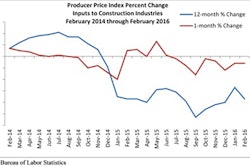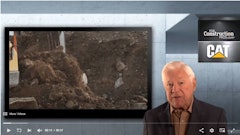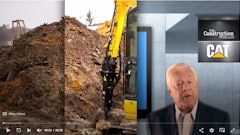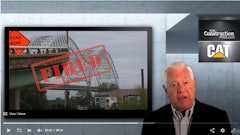Construction News Tracker is present by Caterpillar and produced by ForConstructionPros.com
Is the nation's housing industry headed back to normalcy? That's an area of expertise for Wells Fargo Securities. According to the company, housing starts in February rose 5.2%, and single family construction starts were up 7.2% to the highest level since November of 2007. Multifamily is in a growth mode as well, though not as strong as single family rising just 0.8 of a percent last month, but a far cry from the 9.5% reduction in January.
Western states show the highest growth rate at 24.5% in single family starts followed by southern states. This activity, claims Wells Fargo, is expected to put our housing market in good position for the upcoming selling season.
Placing even more pressure on home building is a report from market search firm Trulia that the nation's starter home inventory has dropped 44% since 2012. The entire home industry faces drastic market changes as prices on existing properties rocket upward, leaving little room for prospective buyers to cut deals.
Recent analysis of the government's Bureau of Labor Statistics Producer Price Index by construction industry economists shows good results for us. Materials prices continue to fall, input prices are off 0.6 of a percent for February and 3.7% average on a yearly basis. Nonresidential construction is off even more at 0.7 of a percent from January and 3.8% back to February of last year. It's all blamed on weak global growth and a weakening U.S. dollar, which in turn puts downward pressure on commodity and materials prices. Eight of the 11 key inputs were lower in February.
A major ruling from the U.S. Labor Department will significantly reduce exposure limits to silica, basically sand used in construction and foundries. Concrete, brick and stone all contain the substance which can be deadly for human lungs if inhaled consistently.
OSHA Issues Final Rule for Silica Dust Exposure
The old silica rule imposed in the 1970s capped exposure at 250 micrograms per cubic meter of air. This new rule sets the limit at 50 micrograms, and there is every indication OSHA will begin searching for offenders soon.
While we all enjoy lower gas and diesel prices, it comes at a price. As an example, California is collecting far less tax revenue, and the result is a drastic reduction in highway construction funding. The combined loss of CDOT revenue is now over a billion dollars, and the agency is being forced to re-examine some 225 shovel-ready projects for either cancellation or delay.
State transportation officials have already trimmed $754 million for this year and are looking to scale back an additional $328 million next year as the revenue stream just isn't there. Other states also face similar scenarios of money shortages.
Caterpillar recently conducted a production study to determine just how much new technology affects a customer's bottom line. Using its Peoria proving grounds, Cat built two identical roads, side by side, with the only difference integrated technology on one and the other built the old fashioned way. Their goal: to measure the differences this new technology affords in job time, machine hours, man hours and fuel burned.
Karl Weiss, vice president of earthmoving, says the effort was successful in giving Cat the data to show customers the workflow differences that result from the new benefits on installed technology. The result: 46% less production hours on the tech-enabled product as well as a 37% drop in fuel use.
World of Asphalt has just concluded its meeting for the year, and our editor Lisa Cleaver was among those that attended...
[VIDEO] New Products, Technologies Highlighted at World of Asphalt 2016
It's labeled the BEAST, but that's just an easy way to say Bridge Evaluation and Accelerated Structural Testing. Whew.
It comes from Rutgers University Center for Advanced Infrastructure and Transportation. In any case, the BEAST is designed to measure stresses and deterioration of bridges caused by traffic and environmental issues, and fast forwards again by 30 times.
The result is the ability to simulate 15 to 20 years of wear and tear in just a few months' time. The device loading feature alone can replicate 24/7 traffic of up to 60,000 pounds applied vertical force in a single day as well as weather and surface treatment conditions — all in a six-month time frame.
In closing, artificial intelligence is no match for natural stupidity.
This is Construction News Tracker looking over the industry that makes the world a better place, presented by Caterpillar and produced by ForConstructionPros.com.
Look for us on Facebook, Twitter using #constructionnews and YouTube as the streaming Web never ends.




![[VIDEO] Need Products, Technologies Highlighted at World of Asphalt 2016](https://img.forconstructionpros.com/files/base/acbm/fcp/image/2016/03/default.56f596d8217a4.png?auto=format%2Ccompress&fit=crop&h=167&q=70&w=250)














